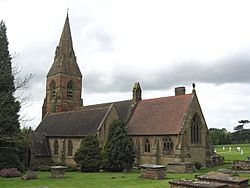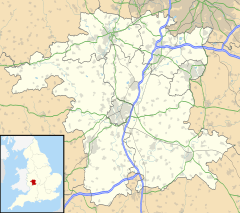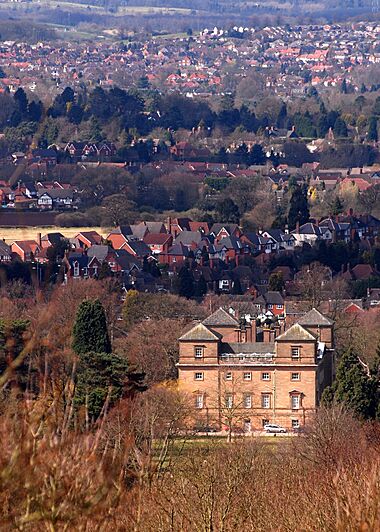Hagley facts for kids
Quick facts for kids Hagley |
|
|---|---|
 St John the Baptist Church |
|
| Population | 4,283 (2001) for Civil Parish; approximately 5600 for the whole village |
| Civil parish |
|
| District |
|
| Shire county | |
| Region | |
| Country | England |
| Sovereign state | United Kingdom |
| Post town | STOURBRIDGE |
| Postcode district | DY8/9 |
| Dialling code | 01562 |
| Police | West Mercia |
| Fire | Hereford and Worcester |
| Ambulance | West Midlands |
| EU Parliament | West Midlands |
| UK Parliament |
|
Hagley is a village and civil parish in Worcestershire, England. A civil parish is a local government area. Hagley is located between the Metropolitan Borough of Dudley and Kidderminster. It sits on the border of the West Midlands and Worcestershire counties. In 2019, about 7,162 people lived there.
Contents
How Hagley Grew
Hagley has a long history. From the time of the Domesday Book until 1933, the area of Hagley was much larger. The Domesday Book was a huge survey of England made in 1086. The original village was on the lower slopes of the Clent Hills. Here you can find Hagley Hall and the old church, St John the Baptist.
The church's records are the oldest in England. They started on December 1, 1538. This was the year when all churches were told to keep records.
West Hagley's Growth
Lower Hagley, now called West Hagley, is downhill from the old village. It started to grow a lot when the Oxford, Worcester and Wolverhampton Railway arrived in 1852. A railway station was built there later. This growth made West Hagley the new main part of the village.
Today, West Hagley has the main shopping area and schools. The exact line between the old and new parts of Hagley is not officially set.
Hagley's Local Government
Hagley is part of the West Midlands Urban Area. This means it's connected to bigger towns like Stourbridge and the Black Country. Roads like the A491 and A456 connect Hagley to these places. The A456 goes from Birmingham to Kidderminster. There is also a regular train service between Kidderminster and Birmingham.
Hagley has more people than some market towns. It even used to have its own cattle market. But it doesn't feel like a market town. It has shops and local services, but not many big job places. Most people who live in Hagley travel to work in Birmingham or the nearby Black Country. This makes it a "dormitory village," meaning people mostly sleep there.
Local Councils
Before 1894, local matters were handled by a church committee. Now, Hagley is part of the Bromsgrove District Council. But it also has its own Parish Council. This council looks after some local places and services. It includes elected councillors and other members.
Hagley's Past
People have lived in the Hagley area for a very long time. We know this from Bronze Age burial mounds. These are old graves found in a field on Stakenbridge Lane. They were dug up in the 1700s. Later, during the Iron Age, a hill fort was built on Wychbury Hill.
A Roman salt road also passed through Hagley. This road was used to transport salt from Droitwich. Roman pottery and coins have been found in the area. The first time Hagley was written about was in the Domesday Book. It was called Hageleia then.
The Lyttelton Family
The Lyttelton family has lived in Hagley since the 1590s. They still live at Hagley Hall today. One famous family member was George Lyttelton, 1st Baron Lyttelton. He was a statesman and a poet. He designed the beautiful gardens at Hagley Hall. He also replaced the old wooden hall with the grand Palladian mansion you see today.
His brother, Charles, was born in Hagley. He later became a bishop. Another family member, William Henry, was a church leader in Hagley for many years.
Hagley's Churches
The Domesday Book mentions that Hagley had a priest. The first church, dedicated to Saint John the Baptist, was made of wood. It was later rebuilt with stone. You can still see parts of this old stone church today. These include a medieval tomb and some old stone carvings.
In the 1800s, the church was largely rebuilt in a Gothic style. A tall red sandstone tower and spire were added.
Newer Churches
As West Hagley grew, a new church was needed. A small church was built in 1882. In 1906, it was replaced by St Saviour’s Church. This church has a stone nave (main part) and chancel (altar area). It has windows designed by Francis Skeat.
There was also a Primitive Methodist chapel nearby. It was built in 1857. In 1905, it was replaced by the Free Church on Worcester Road. This church is still very important to the community today. It was only the second church of its kind in the country.
Old Industries in Hagley
Three streams flow through Hagley. They start on the Clent Hills. These streams are Hagley Brook, Gallows Brook, and Clent Brook. In the past, these streams powered mills. Further downstream, during the Industrial Revolution, several ironworking mills were built. This gave Hagley an industrial side.
There was also a small coal mine that opened for a short time in 1866-67. There is also evidence of early glass-making in the village. But this was likely done in homes, not big factories.
Farming and Markets
Most people in Hagley worked in farming. In the 1700s, there were 13 farms. By the early 1900s, there were 18. But by the end of the 20th century, only two farms remained. The soil in Hagley is sandy and not very rich. So, farmers focused more on raising animals than growing crops.
Hagley had a cattle market by 1600. It was located near where the Hagley road (A491) and Birmingham road (A456) meet. The market grew over the years and was served by the railway. However, the cattle market closed in the 1960s.
Important Places in Hagley
- Hagley Hall: This is the home of the Lyttelton family for many centuries. The head of the family is called Viscount Cobham.
- Hagley Park: This park surrounds Hagley Hall. It is about 350 acres (1.4 km2) of beautiful deer park. It also has a ruined folly (a decorative building) and a restored Palladian bridge.
- Wychbury Hill: This hill has a tall stone monument called an obelisk.
Famous People from Hagley
- Jon Bentley: A TV presenter from shows like Fifth Gear and The Gadget Show.
- Jude Bellingham: A famous English football player who lived in Hagley when he was a child.
- John Bonham: The drummer for the famous band Led Zeppelin. He lived in Hagley from 1969 to 1972.
- Adrian Chiles: A TV presenter who grew up in Hagley.
- Andrew Downes: A composer.
- Clive Everton: A professional snooker player and commentator.
- Jon Ford: A professional footballer.
- Doug Hele: A motorcycle engineer who died in Hagley.
- Jason Koumas: A professional footballer.
- The Lyttelton family: Owners of Hagley Hall.
- Lucy Cavendish: Born at Hagley Hall, she worked to help women get an education.
- Dan O'Hagan: A television football commentator.
- Lee Sharpe: A professional footballer who studied at Hagley Catholic High School.




